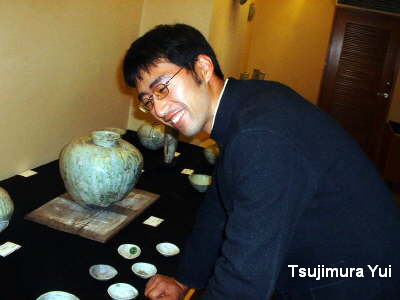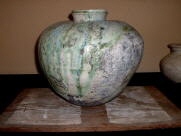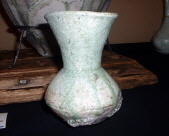|

Click here to
learn about
Tsujimura Kai,
the brother of
Tsujimura Yui
Click here to
learn about
Tsujimura Shiro,
their father

Yellin's gallery
sells pieces from
the kilns of Japan's
finest potters
|
|
|
Tsujimura Yui Exhibit
Hankyu Department Store (Umeda, Osaka)
November 12th to 18th, 2003
Story and Photos by Aoyama Wahei at EY-NET

As I was sipping sake with Tsujimura Kai one evening at his home in Nara, he brusquely asked me if I had seen his brother's work.
"You have a brother?" was my startled reply.
|
Work by
Tsujimura Yui
Includes Yui's
unique turtle ware |
|
Though in fear of being categorical, I believe Japan has traditionally deemed the first son as heir to a legacy, the defender of the throne, the son that passes on a rich heritage to the following generation. The second son, on the other hand, oft chooses a different road to tread.
Even if I did know of Tsujimura Yui's existence, I imagine I would have assumed Kai to be the first son. This is because Kai is, in many ways, a staunch protector of his father's aesthetic sensibilities. Kai forms Iga and Shigaraki wares, uses kohiki slip, paints Karatsu, makes large Yakishime tsubo, much like his father Shiro. It is without a doubt that Shiro's ideals live inside Kai, so much, in fact, that at times it is difficult to differentiate the two.
On the other hand, Tsujimura Yui's works are unlike his father Shiro or younger brother Kai. For that matter, perhaps it is safe to say that his works are quite different from any other potter working today. This in no way alludes to Yui being avant-garde, post-modern, or sculptural as opposed to functional. Rather, Yui is original in that he has found a mode of creative expression by looking to the past -- the 5th century AD, to be exact. That's quite a time-slip for a young man (Yui is 28) to fall into.
|
Tsubo (large jars)
by Tsujimura Yui
 |
|
Yui's mode of expression is Sueki. Thought to have originated in Kudara, an ancient kingdom that thrived in the Korean peninsula, Sueki is stoneware, often large jars and flasks fired above 1000 degrees celsius, typically colored with a blue/green ash glaze. The various Sueki forms evoke thoughts of ancient people and far-away lands, of tribal villages with mud-floor huts and straw roofs, where the wielding of fire meant authority and an age where pottery was integral to village society.
Visiting Tsujimura Yui's exhibit in Osaka opened my eyes to the wealth of originality that can be tapped through reverence towards the past. Yet what is reverence? Does it mean to love and respect the styles or methods of peoples of the past? Does it mean utter indentured servitude to bygone days, to ancient ways no longer in tune with modern times?
Yui is hardly as serious. Is there any underlying reason for why you choose Sueki as your mode of expression, I asked.
Says Yui: "Why? For no reason in particular. Sometimes I don't understand why people take these things so seriously. It's not that I think Sueki is different, or that it's a mode of expression that best suits me. I just make what I want to make. I ended up making Sueki. It's not like I always wanted to make Sueki, or that I had known of Sueki for a long time."
I stood befuddled, for in many ways, it is difficult to grasp this artist's raison d'etre. He laughs as he talks; his spectacles glisten in the dim gallery light. He simply shrugs connotations and stereotypes off his shoulders, as if the world was a joke. Yet it is not that he isn't serious about what he does. Instead, Tsujimura Yui would rather not place seriousness into something he enjoys doing. He enjoys his work. And what he enjoys to do at present is to make Sueki: it's nothing more and nothing less.
Says Yui: "I think the first thing I made was an Ido guinomi. I don't really know why I made it. I started making them en masse, and then I started making bigger things, like yunomi and tokkuri. Then vases, flasks, then tsubo. I kept on spinning and firing, spinning and firing, and pretty soon, I had a lot of pots. I kept on practicing. And when I came to my senses, it happened to be that I was making forms that resembled Sueki."
Yui's humor is dry. He is nonchalantly cool and easy going. Yet there is a softness to him that resembles his pots -- vaguely nostalgic yet vastly distant from his contemporaries.
|
Yokobin by Tsujimura Yui
Yellin looking at the pots
lying around Yui's kiln.
Various sakazuki by
Tsumijura Yui |
|
His wit can be seen in original wares not traditionally found in Sueki. The turtle flask, or kamebin, is Yui's original creation, a ware that cannot be found in history books. It reminds one of a Chinese bronze gong, yet with a neck protruding from the top of it's round body. It looks, quite simply, like a turtle. When I first saw this style lying in vast numbers beside Yui's kiln, I immediately bent down to my knees to pick one up. It's something you just want to hold and hug. In its playful form was locked not only Yui's creativity, but also his sharp sensibility for making wares that are distinctively his own, not mere carbon copies of wares past.
Yui has also created a world of monochrome, of colors that can be represented with three words: gray, blue, and green. Yet in this abbreviated palette of colors lies a depth of life.
In his baby blue lagoons, found within the wells of his chawan, are trapped a pristine and timeless beauty. His baby blue, originating from his natural ash glaze that covers his work, is not often seen within his father or brother's works. With Yui, this blue abounds. And in his pale greens lie a color that recalls the jade of ancient China, of ages gone by in rich culture and history. The man may scoff at seriousness, yet in his works lies an aesthetic that had been nurtured through millennia.
|
Work of
Tsujimura Yui
 |
|
An elderly woman, holding one of Yui's vases in her hands, pauses to ask Yui what clay he uses in his works. This is because unlike typical Shigaraki, Yui's earth is less bumpy and more refined, as well as possessing a grayish-white tone.
Yes, I use Shigaraki and Iga earth that I dig up myself from construction sites in the two regions. I blend the clays with other clays as well, hence the smoother, whiter texture.
It is true that his Iga wares are much smoother than typical Iga. This smoothness, in overall effect, can be seen as a detriment to Yui's pieces. This is because his present deference towards Sueki means he must shape his bases in a smoother, almost round-ish shape, which ultimately leads to the piece becoming unbalanced. In other words, many of his works cannot stand on their own two feet. Sueki was made in a time where the kodai, or base, was hardly as pronounced. The antediluvian base was molded, not cut. Thus, base rings must be placed underneath the pots in order to keep them from tipping over. At Yui's exhibition, such rings could be seen. In terms of function, I think this impracticality is a drawback. However, my belief is that Yui's base, in this present shape, is simply another sign of Yui's creativity and wit. One look at his excellent chawan fully illustrates this man's ability to cut highly skilled kodai. However, Yui's consistent making of Sueki bases shows his lofty knack to take it all in stride, to skip away from suffocating stiffness, to laugh it all away. I strongly feel that such can only come from an absolute confidence in one's own talent.
This is also my own creation, he says, as Yui points to a tokkuri shape that calls to mind a tiny pumpkin. The base was round and prone to topple if the tokkuri was not filled to the brim. Yet at such an expense lay a highly amusing nature in form. To hold the tokkuri in one's palm; it's roundness fit snugly within the hand, and the effect it had on me could be clearly seen in my smile.
Explains Yui: "Most magazines like to write that I apprenticed underneath my father before building a kiln of my own- the same for Kai. Yet to be honest, my father never really taught us a thing. We just lived with him, and helped him mix clay when we were young. But it doesn't matter. If it makes them happy, let them write what they want. Words or phrases are not going to change how I work."
Indeed.
Tsujimura Yui's debut exhibition is rich. It is without question that Yui is amazingly talented. Yet not only does Yui have talent, he has the diligence to better himself. The number of times he has fired works in his anagama are far more than the average potter, or highly proficient potters, as well. Like his father and brother, Yui fires numerous times, often once a week, in order to hone his skills. The forms I saw at Yui's exhibition were such products of meticulous practice and care.
In many ways, such tireless work cannot be surpassed. If one has both talent and perseverance towards working hard, the results will often be beautiful. What I saw before my eyes in Osaka was exactly that: the byproduct of talent and labor. And an uncanny wit as well. Tsujimura Yui's works are quickly catching the spotlight, as the magazine Tohjiro has named Yui the next breed of great chawan potters. I agree; Tsujimura is making fresh new forms from ancient ones. This creativity, as well as courage, should not be underestimated.
LEARN MORE ABOUT
THE TSUJIMURA FAMILY
|
|